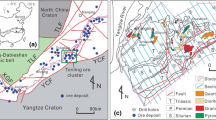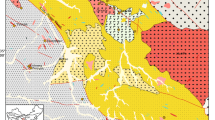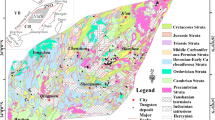Abstract
With the increasing use of machine learning for big data analytics, several methods have been implemented for the purpose of exploration targeting using mineral potential mapping in a GIS environment. Random forests (RF) have been successfully applied to data-driven mineral potential mapping using relatively small numbers of input maps that have typically been pre-classified by a geologist familiar with the mineral system being targeted. However, it is useful to understand how well RF perform for mineral potential mapping when a large number of multi-class categorical or non-thresholded numeric input maps are used in the classification or when weighted or ranked training data are used. Four different implementations of RF are presented to examine how the results vary depending on the degree of intervention from an expert in the modeling process. A case study has been devised using data from the eastern Lachlan Orogen in New South Wales (Australia) for the purposes of targeting porphyry Cu–Au mineralization related to the Macquarie Arc. The results demonstrate that the use of a large number of multi-class categorical or non-thresholded numeric predictive input maps results in a poor mineral potential map outcome. An expert review to determine reclassifications or thresholds that produce geologically meaningful maps as proxies for the mineral system being targeted results in more effective RF-based mineral potential maps being produced. Weighting or ranking the deposits used as training data produces more narrowly defined prospective areas that may assist with targeting tier-one economic deposits. Comparison of the RF results to a standard weights of evidence analysis highlighted some significant differences in which predictive maps should be considered important for modeling, and in the extent of prospective area delineated from each output mineral potential map.






Similar content being viewed by others
References
Agterberg, F. P. (2011). A modified weights-of-evidence method for regional mineral resource estimation. Natural Resources Research,20, 95–101.
Agterberg, F. P., & Cheng, Q. (2002). Conditional independence test for weights-of-evidence modeling. Natural Resources Research,11, 249–255.
Blevin, P. L. (2002). The petrographic and compositional character of variably K-enriched magmatic suites associated with Ordovician porphyry Cu–Au mineralisation in the Lachlan Fold Belt, Australia. Mineralium Deposita,37, 87–99.
Bonham-Carter, G. (1994). Geographic information systems for geoscientists: Modelling with GIS. Oxford: Pergamon Press.
Bougrain, L., Gonzalez, M., Bouchot, V., Cassard, D., Lips, A. L. W., Alexandre, F., et al. (2003). Knowledge recovery for continental-scale mineral exploration by neural networks. Natural Resources Research,12, 173–181.
Breiman, L. (2001). Random forests. Machine Learning,24, 123–140.
Brown, W. M., Gedeon, T. D., & Groves, D. I. (2003). Use of noise to augment training data: A neural network method of mineral-potential mapping in regions with limited known deposit examples. Natural Resources Research,12, 141–152.
Brown, W. M., Gedeon, T. D., Groves, D., & Barnes, R. G. (2000). Artificial neural networks: A new method for mineral prospectivity mapping. Australian Journal of Earth Sciences,47, 757–770.
Carranza, E. J. M. (2014). Data-driven evidential belief modeling of mineral potential using few prospects and evidence with missing values. Natural Resources Research,24, 291–304.
Carranza, E. J. M., & Hale, M. (2002). Evidential belief functions for data-driven geologically constrained mapping of gold potential, Baguio district, Philippines. Ore Geology Reviews,22, 117–132.
Carranza, E. J. M., & Laborte, A. G. (2015a). Data-driven predictive mapping of gold prospectivity, Baguio district, Philippines: Application of random forests algorithm. Ore Geology Reviews,71, 777–787.
Carranza, E. J. M., & Laborte, A. G. (2015b). Random forest predictive modeling of mineral prospectivity with small number of prospects and data with missing values in Abra (Philippines). Computers and Geosciences,74, 60–70.
Carranza, E. J. M., & Laborte, A. G. (2016). Data-driven predictive modeling of mineral prospectivity using random forests: A case study in Catanduanes Island (Philippines). Natural Resources Research,25, 35–50.
Carranza, E. J. M., Woldai, T., & Chikambwe, E. M. (2005). Application of data-driven evidential belief functions to prospectivity mapping for aquamarine-bearing pegmatites, Lundazi District, Zambia. Natural Resources Research,14, 47–63.
Chung, C.-J. F., & Fabbri, A. G. (2003). Validation of spatial prediction models for landslide hazard mapping. Natural Hazards,30, 451–472.
Crawford, A. J., Meffre, S., Squire, R. J., Barron, L. M., & Falloon, T. J. (2007). Middle and Late Ordovician magmatic evolution of the Macquarie Arc, Lachlan Orogen, New South Wales. Australian Journal of Earth Sciences,54, 181–214.
ESRI. (2019). ArcGIS Pro Release 2.4. Redlands, California.
Fallon, M., Porwal, A., & Guj, P. (2010). Prospectivity analysis of the plutonic Marymia greenstone belt, Western Australia. Ore Geology Reviews,38, 208–218.
Ford, A., & Hart, C. J. R. (2013). Mineral potential mapping in frontier regions: A Mongolian case study. Ore Geology Reviews,51, 15–26.
Ford, A., Miller, J. M., & Mol, A. G. (2015). A comparative analysis of weights of evidence, evidential belief functions, and fuzzy logic for mineral potential mapping using incomplete data at the scale of investigation. Natural Resources Research,25, 19–33.
Ford, A., Peters, K., Greenfield, J., Blevin, P., Downes, P., Fitzherbert, J., & Simpson, B. (2019b). Eastern Lachlan Orogen mineral potential data package first edition [Digital Dataset]. Geological survey of New South Wales, Maitland. https://search.geoscience.nsw.gov.au/product/9253. Accessed 17 Oct 2019.
Ford, A., Peters, K. J., Partington, G. A., Blevin, P. L., Downes, P. M., Fitzherbert, J. A., et al. (2019a). Translating expressions of intrusion-related mineral systems into mappable spatial proxies for mineral potential mapping: Case studies from the Southern New England Orogen, Australia. Ore Geology Reviews,111, 102943.
Forster, D. B., Carr, G. A., & Downes, P. M. (2011). Lead isotope systematics of ore systems of the Macquarie Arc—Implications for arc substrate. Gondwana Research,19, 686–705.
Fox, N., Cooke, D. R., Harris, A., Collett, D., & Eastwood, G. (2015). Porphyry Au–Cu mineralization controlled by reactivation of an arc-transverse volcanosedimentary subbasin. Geology,43, 811–814.
Fung, C. C., Iyer, V., Brown, W., & Wong, K. W. (2005). Comparing the performance of different neural networks architectures for the prediction of mineral prospectivity. In Proceedings of the fourth international conference on machine learning and cybernetics, Guangzhou (pp. 394–398).
Geological Survey of New South Wales. (2019). NSW MetIndEx (metallic, industrial mineral and exploration discoveries) database [Digital Dataset]. Maitland: Geological Survey of New South Wales.
Glen, R. A., Crawford, A. J., & Cooke, D. R. (2007). Tectonic setting of porphyry Cu–Au mineralization in the Ordovician—Early Silurian Macquarie Arc, Eastern Lachlan Orogen, New South Wales. Australian Journal of Earth Sciences,54, 465–479.
Glen, R. A., Saeed, A., Quinn, C. D., & Griffin, W. L. (2011). U–Pb and Hf isotope data from zircons in the Macquarie Arc, Lachlan Orogen: Implications for arc evolution and Ordovician palaeogeography along part of the east Gondwana margin. Gondwana Research,19, 670–685.
Guj, P., Fallon, M., McCuaig, T. C., & Fagan, R. (2011). A time-series audit of Zipf’s Law as a measure of terrane endowment and maturity in mineral exploration. Economic Geology,106, 241–259.
Hariharan, S., Tirodkar, S., Porwal, A., Battacharya, A., & Joly, A. (2017). Random forest-based prospectivity modelling of greenfield terrains using sparse deposit data: An example from the Tanami Region, Western Australia. Natural Resources Research,26, 489–507.
Harris, J. R., & Sanborn-Barrie, M. (2006). Mineral potential mapping: Examples from the Red Lake greenstone belt, northwest Ontario. In J. R. Harris (Ed.), GIS for the earth sciences (pp. 1–21). London: Geological Association of Canada Special Publication 44.
Harris, J. R., Sanborn-Barrie, M., Panagapko, D. A., Skulski, T., & Parker, J. R. (2006). Gold prospectivity maps of the Red Lake greenstone belt: Application of GIS technology. Canadian Journal of Earth Sciences,43, 865–893.
Harris, D., Zurcher, L., Stanley, M., Marlow, J., & Pan, G. (2003). A comparative analysis of favorability mappings by weights of evidence, probabilistic neural networks, discriminant analysis, and logistic regression. Natural Resources Research,12, 241–255.
Hronsky, J. M. A., & Kreuzer, O. P. (2019). Applying spatial prospectivity mapping to exploration targeting: Fundamental practical issues and suggested solutions for the future. Ore Geology Reviews,107, 647–653.
Joly, A., Porwal, A., & McCuaig, T. C. (2012). Exploration targeting for orogenic gold deposits in the Granites-Tanami Orogen: Mineral system analysis, targeting model and prospectivity analysis. Ore Geology Reviews,48, 349–383.
Knox-Robinson, C. M., & Wyborn, L. A. I. (1997). Towards a holistic exploration strategy: Using geographic information systems as a tool to enhance exploration. Australian Journal of Earth Sciences,44, 453–463.
Koutroumbas, K., & Theodoridis, S. (2008). Pattern recognition. Amsterdam: Elsevier.
McKay, G., & Harris, J. R. (2016). Comparison of the data-driven random forests model and a knowledge-driven method for mineral prospectivity mapping: A case study for gold deposits around the Huritz Group and Nueltin Suite, Nunavut, Canada. Natural Resources Research,25, 125–143.
Nykänen, V. (2008). Radial basis functional link nets used as a prospectivity mapping tool for orogenic gold deposits within the Central Lapland Greenstone Belt, Northern Fennoscandian Shield. Natural Resources Research,17, 29–48.
Partington, G. (2010). Developing models using GIS to assess geological and economic risk: An example from VMS copper gold mineral exploration in Oman. Ore Geology Reviews,38, 197–207.
Porwal, A., Carranza, E. J. M., & Hale, M. (2001). Extended weights-of-evidence modelling for predictive mapping of base metal deposit potential in Aravalli Province, Western India. Exploration and Mining Geology,10, 273–287.
Porwal, A., Carranza, E. J. M., & Hale, M. (2003). Artificial neural networks for mineral-potential mapping: A case study from Aravalli Province, Western India. Natural Resources Research,12, 155–171.
Reddy, R. K. T., & Bonham-Carter, G. F. (1991). A decision-tree approach to mineral potential mapping in Snow Lake area, Manitoba. Canadian Journal of Remote Sensing,17, 191–200.
Rodriguez-Galiano, V. F., Chica-Olmo, M., & Chica-Rivas, M. (2014). Predictive modelling of gold potential with the integration of multisource information based on random forest: A case study on the Rodalquilar area, Southern Spain. International Journal of Geographical Information Science,28, 1336–1354.
Rodriguez-Galiano, V., Sanchez-Castillo, M., Chica-Olmo, M., & Chica-Rivas, M. (2015). Machine learning predictive models for mineral prospectivity: An evaluation of neural networks, random forest, regression trees and support vector machines. Ore Geology Reviews,71, 804–818.
Sagiroglu, S., & Sinanc, D. (2013). Big data: A review. In Proceedings of the international conference on collaboration technologies and systems, San Diego, California (pp. 42–47).
Singer, D. A., & Kouda, R. (1999). A Comparison of the weights of evidence method and probabilistic neural networks. Natural Resources Research,8, 287–298.
Wang, J., Zuo, R., & Xiong, Y. (2019). Mapping mineral prospectivity via semi-supervised random forest. Natural Resources Research. https://doi.org/10.1007/s11053-019-09510-8.
Xiong, Y., Zuo, R., & Carranza, E. J. M. (2018). Mapping mineral prospectivity through big data analytics and a deep learning algorithm. Ore Geology Reviews,102, 811–817.
Yousefi, M., Kreuzer, O. P., Nykänen, V., & Hronsky, J. M. A. (2019). Exploration information systems—A proposal for the future use of GIS in mineral exploration targeting. Ore Geology Reviews,111, 103005.
Zhang, Z., Zuo, R., & Xiong, Y. (2016). A comparative study of fuzzy weights of evidence and random forests for mapping mineral prospectivity for skarn-type Fe deposits in the southwestern Fujian metallogenic belt, China. Science China Earth Sciences,59, 556–572.
Acknowledgments
The author would like to thank the Geological Survey of New South Wales for financial and in-kind support for the WofE mineral potential mapping presented in this paper. Thanks also go to the many geologists in industry, government, and academia who have contributed to the data collection and mineral system ideas used in this study. Two anonymous reviewers and the editor are also thanked for their comments, which helped to improve the quality of the manuscript.
Author information
Authors and Affiliations
Corresponding author
Rights and permissions
About this article
Cite this article
Ford, A. Practical Implementation of Random Forest-Based Mineral Potential Mapping for Porphyry Cu–Au Mineralization in the Eastern Lachlan Orogen, NSW, Australia. Nat Resour Res 29, 267–283 (2020). https://doi.org/10.1007/s11053-019-09598-y
Received:
Accepted:
Published:
Issue Date:
DOI: https://doi.org/10.1007/s11053-019-09598-y




